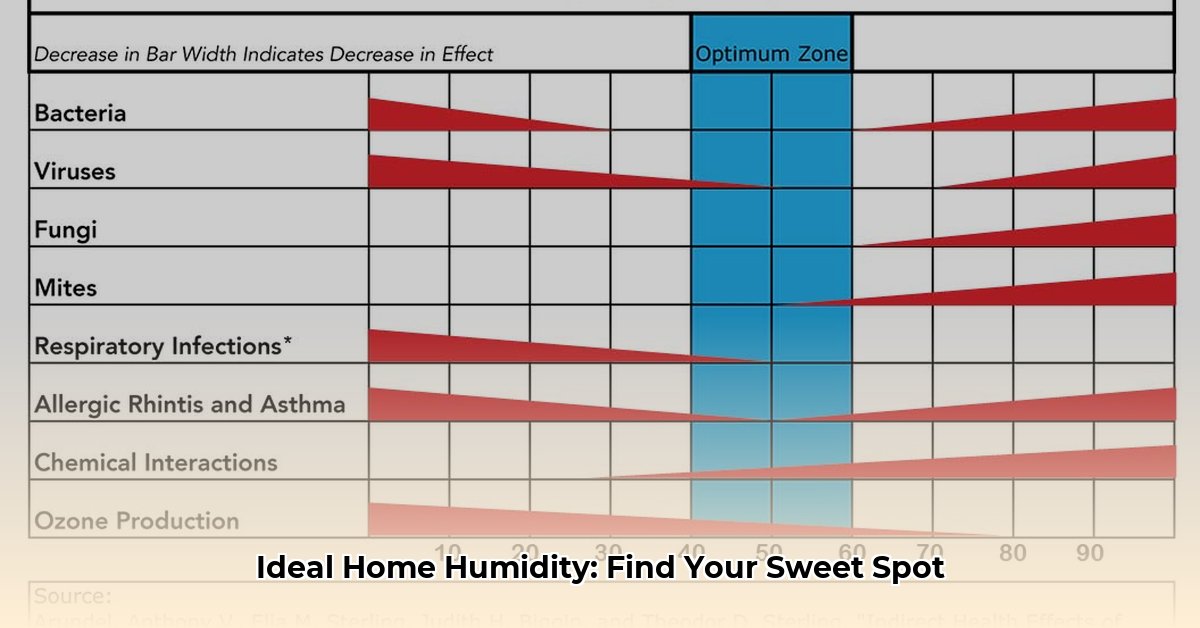Maintaining the right humidity in your home can significantly impact your comfort, health, and even the structural integrity of your house. This comprehensive guide provides everything you need to know about achieving and maintaining the ideal humidity level.
Why Humidity Matters
Proper humidity levels are crucial for a healthy and comfortable home environment. A relative humidity (RH) between 30% and 50% is generally considered ideal. Outside this range, you may experience a variety of issues.
Health Impacts
- Low Humidity (Below 30% RH): Dry air can lead to dry skin, irritated nasal passages, increased susceptibility to respiratory infections, and potentially worsened allergy symptoms. Some studies suggest it may even facilitate the spread of certain viruses.
- High Humidity (Above 50% RH): Excessive moisture creates a breeding ground for mold, mildew, and dust mites, all common allergy and asthma triggers. It can also exacerbate existing respiratory conditions.
Home Impacts
- Low Humidity: Can cause wood furniture and floors to crack, warp, or shrink, and damage musical instruments. Static electricity is also more prevalent in dry air.
- High Humidity: Can lead to sticking doors and windows, peeling paint, musty odors, and potentially even structural damage over time due to rot and decay.
Measuring and Controlling Humidity
Managing your home’s humidity starts with understanding its current level.
Measuring Humidity
A hygrometer, available at most hardware stores or online, measures the amount of moisture in the air. Digital hygrometers provide precise readings, while analog versions offer a more traditional aesthetic. Some modern thermostats also include built-in hygrometers. For the most accurate readings, place the hygrometer away from direct sunlight, vents, and other sources of heat or moisture. You may even consider using multiple hygrometers in different rooms, as humidity can vary throughout your home.
Controlling Humidity
Once you know your humidity level, you can take steps to adjust it.
Increasing Humidity (Dry Air)
- Humidifiers: These devices add moisture to the air. Choose from portable units for individual rooms or whole-house humidifiers that integrate with your HVAC system. Regular cleaning is essential to prevent mold and bacteria growth.
- Natural Methods: While less precise, placing bowls of water near heat sources, boiling water on the stove, letting laundry air-dry, or incorporating houseplants can increase humidity. Houseplants release moisture through transpiration, contributing to a more humid environment.
Decreasing Humidity (Excess Moisture)
- Dehumidifiers: These appliances extract excess moisture from the air. Like humidifiers, they come in portable and whole-house models.
- Ventilation: Proper ventilation is key. Use exhaust fans in bathrooms and kitchens, especially after showering or cooking. Consider installing an Energy Recovery Ventilator (ERV) or a Heat Recovery Ventilator (HRV) for improved whole-house ventilation and energy efficiency.
- Addressing Leaks: Repair any leaks promptly. Even small drips can contribute significantly to indoor humidity over time.
Seasonal Considerations
Humidity levels naturally fluctuate with the seasons.
- Winter: Cold air holds less moisture, often leading to dry indoor air. During winter, you’ll likely need to use a humidifier more frequently or employ other methods to add moisture.
- Summer: Warm air holds more moisture, which can make indoor spaces feel damp and muggy. Dehumidifiers and increased ventilation are crucial during summer months.
Humidity and Specific Concerns
Mold and Dust Mites
Mold and dust mites thrive in humid environments. Keeping humidity below 60% significantly reduces the likelihood of mold growth. Regular cleaning, especially vacuuming and dusting, is essential for controlling dust mites. Allergen-proof covers on mattresses and pillows can also help.
Health Conditions
Maintaining optimal humidity is particularly important for individuals with allergies, asthma, or other respiratory conditions. If you have specific concerns, consult with a healthcare professional.
Advanced Technologies
Smart humidifiers and dehumidifiers offer automated humidity control, allowing you to monitor and adjust levels remotely via smartphone apps. Some models integrate with smart thermostats and other home automation systems.
Frequently Asked Questions (FAQ)
-
Q: What if my humidifier/dehumidifier isn’t working properly?
- A: First, check for clogs or obstructions and ensure the reservoir is full (humidifier) or empty (dehumidifier). Consult the manufacturer’s instructions or contact customer support if the issue persists.
-
Q: Do I need a humidifier/dehumidifier in every room?
- A: Not necessarily. Prioritize areas where humidity fluctuations are most noticeable, such as bedrooms, living rooms, and home offices.
Conclusion
Managing your home’s humidity is an ongoing process, but the benefits are well worth the effort. By understanding the factors that influence humidity and implementing appropriate control measures, you can create a living space that is comfortable, healthy, and protected from moisture-related damage. While the recommended 30-50% RH range is a good starting point, individual needs may vary. Don’t hesitate to experiment and find what works best for you and your family.
- How to Measure Your Belt Size (for Women): 3 Easy & Accurate Methods - April 27, 2025
- How to Remove Permanent Hair Dye From Hair: Safe & Effective Methods - April 27, 2025
- How to Remove Ink from Leather: Effective DIY Methods and Expert Tips - April 27, 2025










